University Financial Accounting Report: Impairment Testing Analysis
VerifiedAdded on 2020/05/28
|10
|2701
|121
Report
AI Summary
This report analyzes advanced financial accounting concepts, specifically focusing on impairment testing and lease accounting, referencing Computershare Limited's 2017 annual report. It examines the company's approach to impairment testing of intangible assets, including goodwill and mortgage servicing rights, detailing the methodologies used, such as value-in-use calculations and discounted cash flow methods. The report highlights key assumptions, the subjectivity involved, and interesting aspects of the impairment testing process, including the adoption of a new impairment model and the treatment of fair value measurement. Furthermore, the report delves into the implications of new accounting standards for leases (IFRS 16), discussing its impact on financial statements, the rationale behind the changes, and the potential effects on various industries and investment decisions. The report also explores the chairpersons of the IASB's perspective on the new standards, including the shift towards reflecting economic reality and the impact on balance sheets and investment decisions.
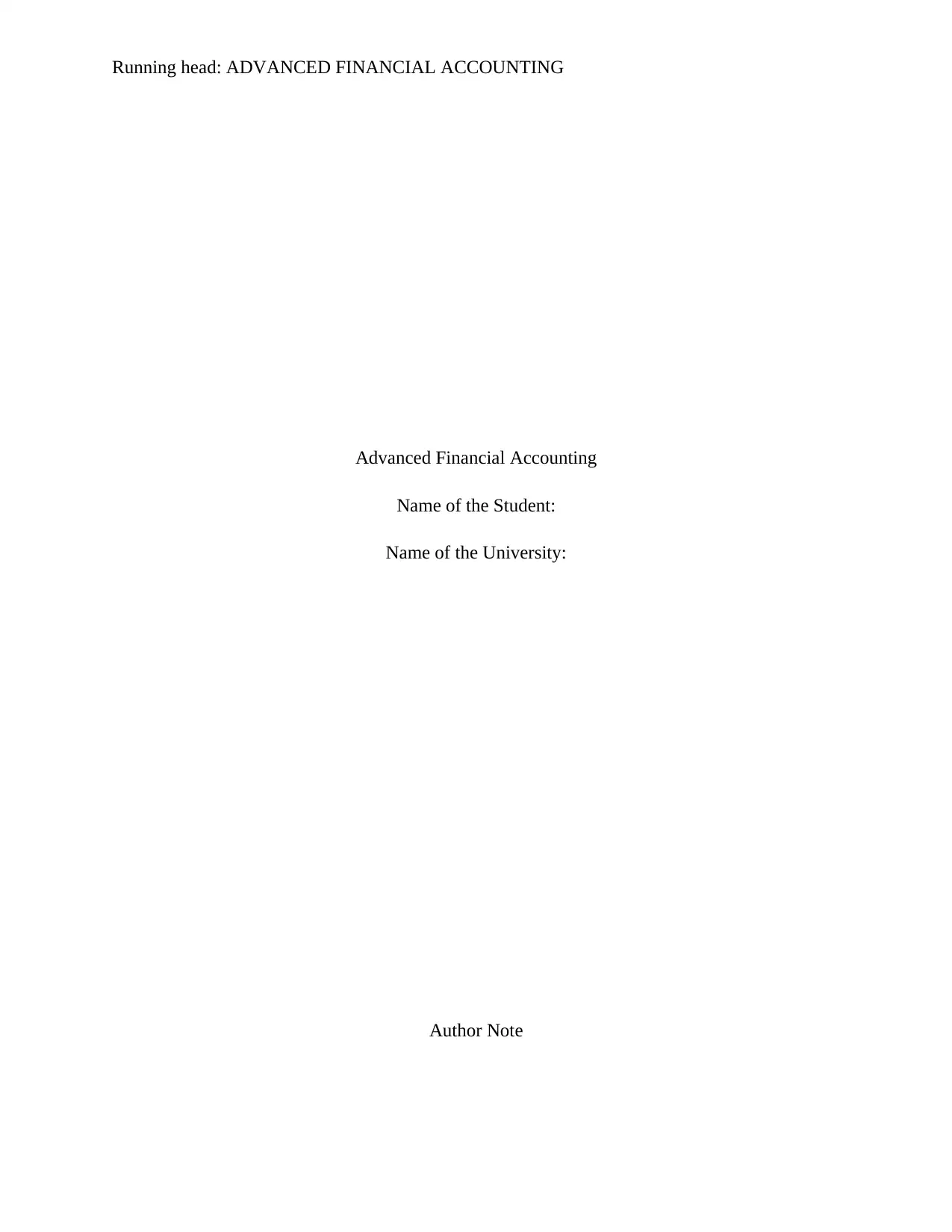
Running head: ADVANCED FINANCIAL ACCOUNTING
Advanced Financial Accounting
Name of the Student:
Name of the University:
Author Note
Advanced Financial Accounting
Name of the Student:
Name of the University:
Author Note
Paraphrase This Document
Need a fresh take? Get an instant paraphrase of this document with our AI Paraphraser
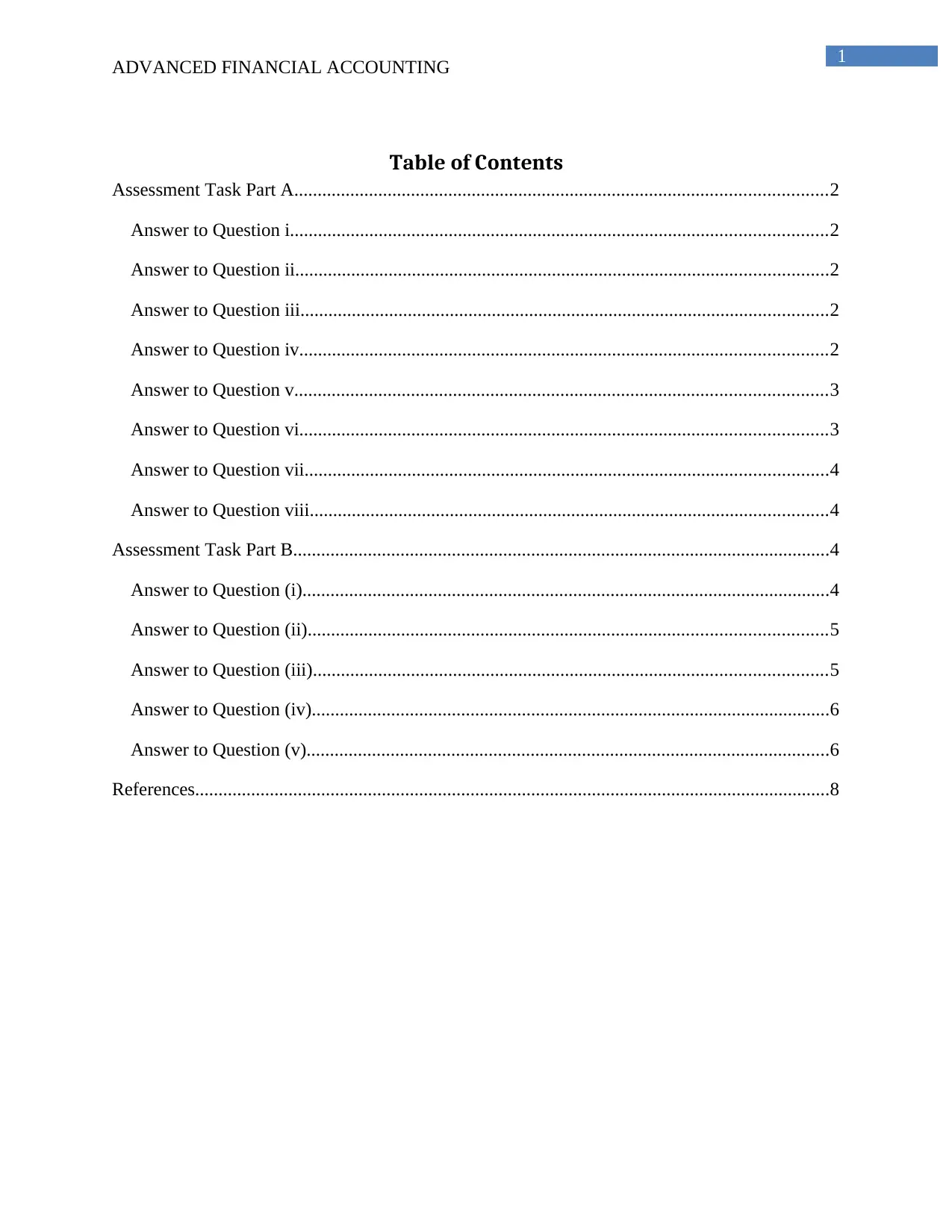
1
ADVANCED FINANCIAL ACCOUNTING
Table of Contents
Assessment Task Part A..................................................................................................................2
Answer to Question i...................................................................................................................2
Answer to Question ii..................................................................................................................2
Answer to Question iii.................................................................................................................2
Answer to Question iv.................................................................................................................2
Answer to Question v..................................................................................................................3
Answer to Question vi.................................................................................................................3
Answer to Question vii................................................................................................................4
Answer to Question viii...............................................................................................................4
Assessment Task Part B...................................................................................................................4
Answer to Question (i).................................................................................................................4
Answer to Question (ii)...............................................................................................................5
Answer to Question (iii)..............................................................................................................5
Answer to Question (iv)...............................................................................................................6
Answer to Question (v)................................................................................................................6
References........................................................................................................................................8
ADVANCED FINANCIAL ACCOUNTING
Table of Contents
Assessment Task Part A..................................................................................................................2
Answer to Question i...................................................................................................................2
Answer to Question ii..................................................................................................................2
Answer to Question iii.................................................................................................................2
Answer to Question iv.................................................................................................................2
Answer to Question v..................................................................................................................3
Answer to Question vi.................................................................................................................3
Answer to Question vii................................................................................................................4
Answer to Question viii...............................................................................................................4
Assessment Task Part B...................................................................................................................4
Answer to Question (i).................................................................................................................4
Answer to Question (ii)...............................................................................................................5
Answer to Question (iii)..............................................................................................................5
Answer to Question (iv)...............................................................................................................6
Answer to Question (v)................................................................................................................6
References........................................................................................................................................8
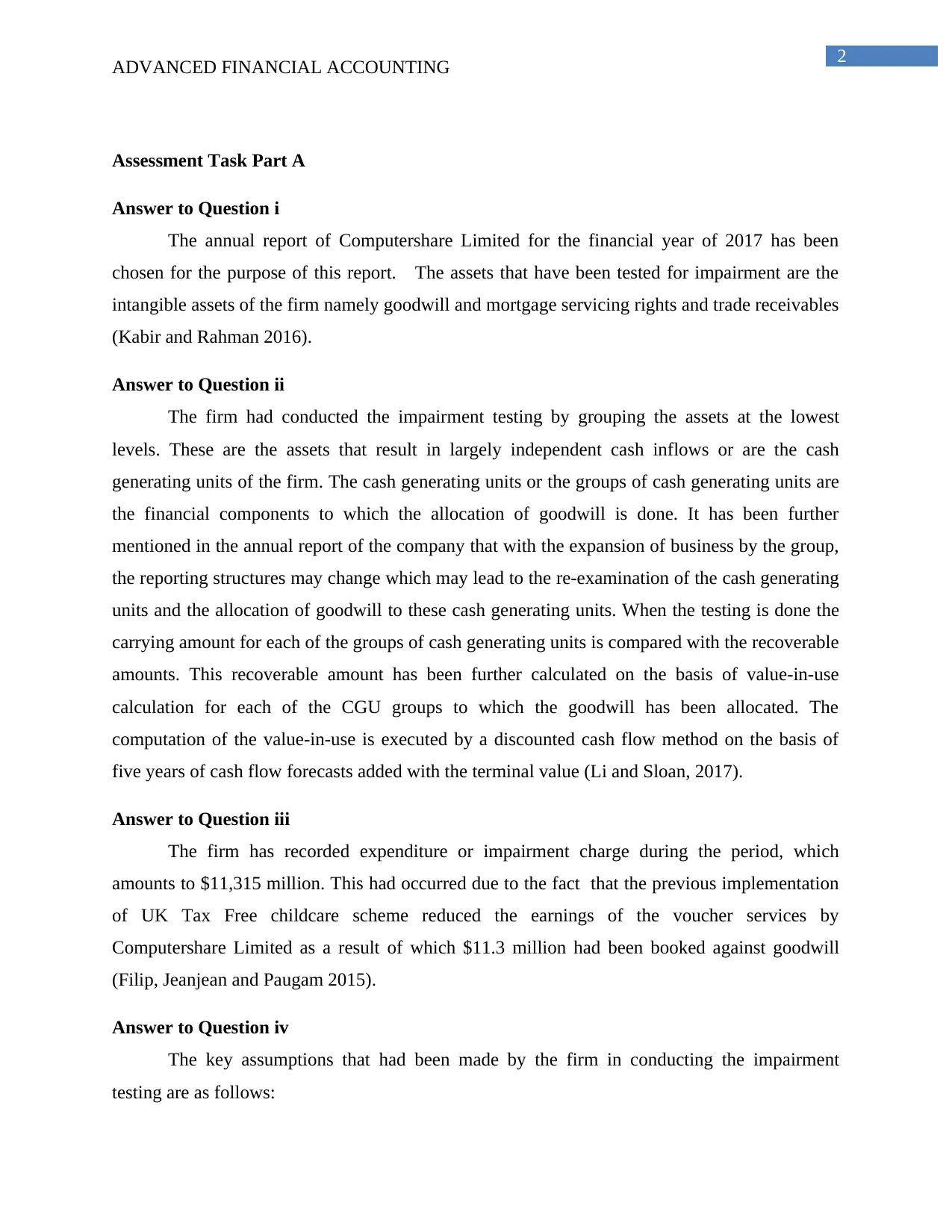
2
ADVANCED FINANCIAL ACCOUNTING
Assessment Task Part A
Answer to Question i
The annual report of Computershare Limited for the financial year of 2017 has been
chosen for the purpose of this report. The assets that have been tested for impairment are the
intangible assets of the firm namely goodwill and mortgage servicing rights and trade receivables
(Kabir and Rahman 2016).
Answer to Question ii
The firm had conducted the impairment testing by grouping the assets at the lowest
levels. These are the assets that result in largely independent cash inflows or are the cash
generating units of the firm. The cash generating units or the groups of cash generating units are
the financial components to which the allocation of goodwill is done. It has been further
mentioned in the annual report of the company that with the expansion of business by the group,
the reporting structures may change which may lead to the re-examination of the cash generating
units and the allocation of goodwill to these cash generating units. When the testing is done the
carrying amount for each of the groups of cash generating units is compared with the recoverable
amounts. This recoverable amount has been further calculated on the basis of value-in-use
calculation for each of the CGU groups to which the goodwill has been allocated. The
computation of the value-in-use is executed by a discounted cash flow method on the basis of
five years of cash flow forecasts added with the terminal value (Li and Sloan, 2017).
Answer to Question iii
The firm has recorded expenditure or impairment charge during the period, which
amounts to $11,315 million. This had occurred due to the fact that the previous implementation
of UK Tax Free childcare scheme reduced the earnings of the voucher services by
Computershare Limited as a result of which $11.3 million had been booked against goodwill
(Filip, Jeanjean and Paugam 2015).
Answer to Question iv
The key assumptions that had been made by the firm in conducting the impairment
testing are as follows:
ADVANCED FINANCIAL ACCOUNTING
Assessment Task Part A
Answer to Question i
The annual report of Computershare Limited for the financial year of 2017 has been
chosen for the purpose of this report. The assets that have been tested for impairment are the
intangible assets of the firm namely goodwill and mortgage servicing rights and trade receivables
(Kabir and Rahman 2016).
Answer to Question ii
The firm had conducted the impairment testing by grouping the assets at the lowest
levels. These are the assets that result in largely independent cash inflows or are the cash
generating units of the firm. The cash generating units or the groups of cash generating units are
the financial components to which the allocation of goodwill is done. It has been further
mentioned in the annual report of the company that with the expansion of business by the group,
the reporting structures may change which may lead to the re-examination of the cash generating
units and the allocation of goodwill to these cash generating units. When the testing is done the
carrying amount for each of the groups of cash generating units is compared with the recoverable
amounts. This recoverable amount has been further calculated on the basis of value-in-use
calculation for each of the CGU groups to which the goodwill has been allocated. The
computation of the value-in-use is executed by a discounted cash flow method on the basis of
five years of cash flow forecasts added with the terminal value (Li and Sloan, 2017).
Answer to Question iii
The firm has recorded expenditure or impairment charge during the period, which
amounts to $11,315 million. This had occurred due to the fact that the previous implementation
of UK Tax Free childcare scheme reduced the earnings of the voucher services by
Computershare Limited as a result of which $11.3 million had been booked against goodwill
(Filip, Jeanjean and Paugam 2015).
Answer to Question iv
The key assumptions that had been made by the firm in conducting the impairment
testing are as follows:
⊘ This is a preview!⊘
Do you want full access?
Subscribe today to unlock all pages.

Trusted by 1+ million students worldwide
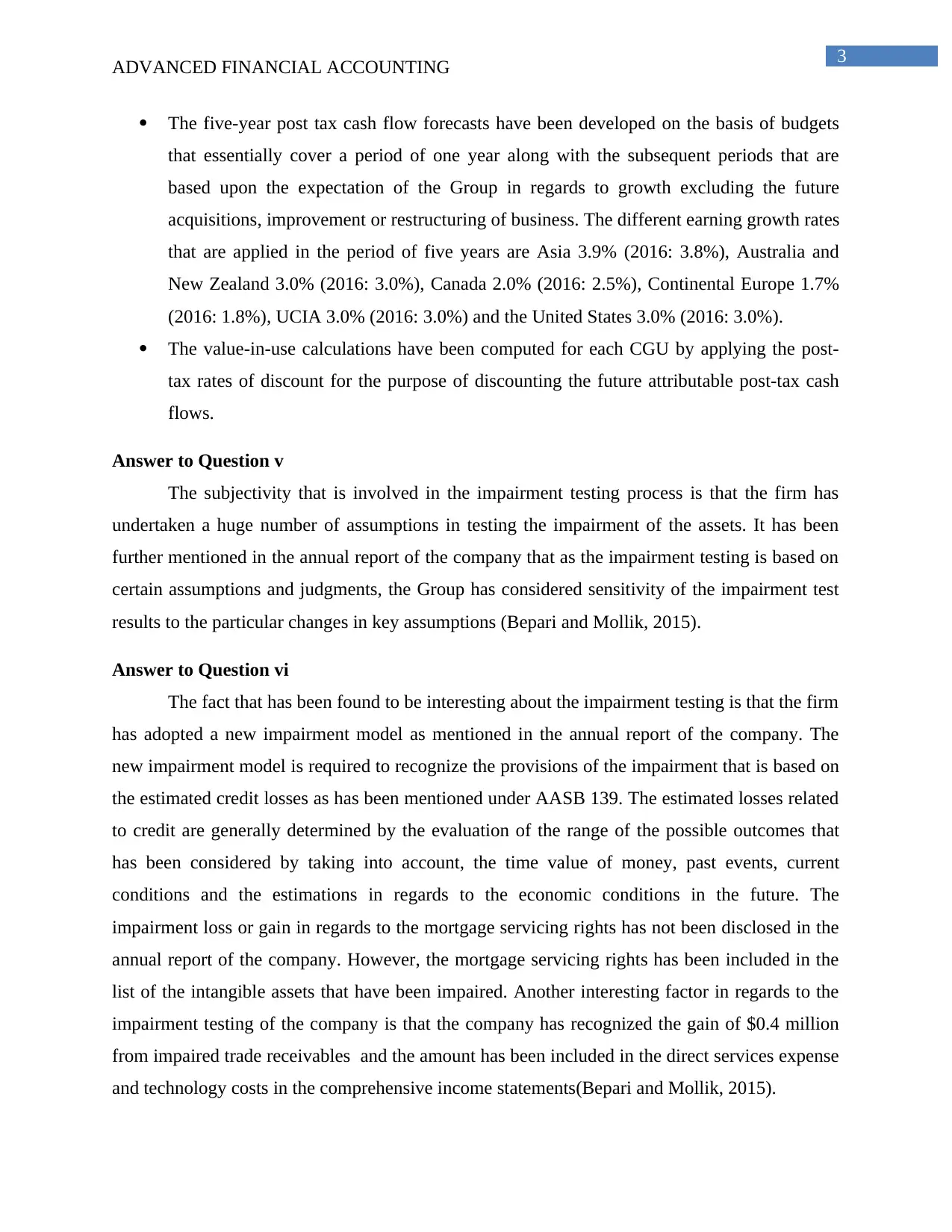
3
ADVANCED FINANCIAL ACCOUNTING
The five-year post tax cash flow forecasts have been developed on the basis of budgets
that essentially cover a period of one year along with the subsequent periods that are
based upon the expectation of the Group in regards to growth excluding the future
acquisitions, improvement or restructuring of business. The different earning growth rates
that are applied in the period of five years are Asia 3.9% (2016: 3.8%), Australia and
New Zealand 3.0% (2016: 3.0%), Canada 2.0% (2016: 2.5%), Continental Europe 1.7%
(2016: 1.8%), UCIA 3.0% (2016: 3.0%) and the United States 3.0% (2016: 3.0%).
The value-in-use calculations have been computed for each CGU by applying the post-
tax rates of discount for the purpose of discounting the future attributable post-tax cash
flows.
Answer to Question v
The subjectivity that is involved in the impairment testing process is that the firm has
undertaken a huge number of assumptions in testing the impairment of the assets. It has been
further mentioned in the annual report of the company that as the impairment testing is based on
certain assumptions and judgments, the Group has considered sensitivity of the impairment test
results to the particular changes in key assumptions (Bepari and Mollik, 2015).
Answer to Question vi
The fact that has been found to be interesting about the impairment testing is that the firm
has adopted a new impairment model as mentioned in the annual report of the company. The
new impairment model is required to recognize the provisions of the impairment that is based on
the estimated credit losses as has been mentioned under AASB 139. The estimated losses related
to credit are generally determined by the evaluation of the range of the possible outcomes that
has been considered by taking into account, the time value of money, past events, current
conditions and the estimations in regards to the economic conditions in the future. The
impairment loss or gain in regards to the mortgage servicing rights has not been disclosed in the
annual report of the company. However, the mortgage servicing rights has been included in the
list of the intangible assets that have been impaired. Another interesting factor in regards to the
impairment testing of the company is that the company has recognized the gain of $0.4 million
from impaired trade receivables and the amount has been included in the direct services expense
and technology costs in the comprehensive income statements(Bepari and Mollik, 2015).
ADVANCED FINANCIAL ACCOUNTING
The five-year post tax cash flow forecasts have been developed on the basis of budgets
that essentially cover a period of one year along with the subsequent periods that are
based upon the expectation of the Group in regards to growth excluding the future
acquisitions, improvement or restructuring of business. The different earning growth rates
that are applied in the period of five years are Asia 3.9% (2016: 3.8%), Australia and
New Zealand 3.0% (2016: 3.0%), Canada 2.0% (2016: 2.5%), Continental Europe 1.7%
(2016: 1.8%), UCIA 3.0% (2016: 3.0%) and the United States 3.0% (2016: 3.0%).
The value-in-use calculations have been computed for each CGU by applying the post-
tax rates of discount for the purpose of discounting the future attributable post-tax cash
flows.
Answer to Question v
The subjectivity that is involved in the impairment testing process is that the firm has
undertaken a huge number of assumptions in testing the impairment of the assets. It has been
further mentioned in the annual report of the company that as the impairment testing is based on
certain assumptions and judgments, the Group has considered sensitivity of the impairment test
results to the particular changes in key assumptions (Bepari and Mollik, 2015).
Answer to Question vi
The fact that has been found to be interesting about the impairment testing is that the firm
has adopted a new impairment model as mentioned in the annual report of the company. The
new impairment model is required to recognize the provisions of the impairment that is based on
the estimated credit losses as has been mentioned under AASB 139. The estimated losses related
to credit are generally determined by the evaluation of the range of the possible outcomes that
has been considered by taking into account, the time value of money, past events, current
conditions and the estimations in regards to the economic conditions in the future. The
impairment loss or gain in regards to the mortgage servicing rights has not been disclosed in the
annual report of the company. However, the mortgage servicing rights has been included in the
list of the intangible assets that have been impaired. Another interesting factor in regards to the
impairment testing of the company is that the company has recognized the gain of $0.4 million
from impaired trade receivables and the amount has been included in the direct services expense
and technology costs in the comprehensive income statements(Bepari and Mollik, 2015).
Paraphrase This Document
Need a fresh take? Get an instant paraphrase of this document with our AI Paraphraser

4
ADVANCED FINANCIAL ACCOUNTING
Answer to Question vii
The new insight that has been gained about how companies conduct impairment testing is
that the effective adherence to the AASB 139 results in the proper ascertainment of the fact
whether companies should recognize an impairment as a loss or gain. It has also been learnt that
the process of impairing an asset is carried out on an ongoing basis. It has been further stated in
the annual report of the company that the impairment is recognized as a profit or loss only when
objective evidence is available in regards to the fact that the company is not able to collect the
due amounts in accordance to the terms of the trade. In spite of the execution of the impairment
of the intangible assets, it has been mentioned in the financial report of the company that the
property, plant and equipment have been stated at historical costs, which has been reduced, by
the amount of depreciation and depreciation. Thus, the impairment of the intangible and fixed
assets are deduced to be different (Rennekamp, Rupar and Seybert 2014).
Answer to Question viii
The fair value measurement for a particular asset or liability refers to the consideration of
the particular features or characteristics of the asset or liability that has to be revalued. This is
essentially executed when the market participants take into account the characteristics of an asset
or liability when the pricing of the asset or the liability has to be computed on the date of
measurement. Moreover, the crucial characteristics of the assets that are considered are as
follows:
The condition or the position of the asset
Any kind of restrictions, if applicable on the utilization or the sale of the asset
The technique that has been adopted by Computershare Limited in regards to the fair
value measurement process has been successful, as the firm has gained a significant amount in
terms of the impairment of the accounts receivables (Rennekamp, Rupar and Seybert 2014).
Assessment Task Part B
Answer to Question (i)
The chairperson of the IASB believes that the former accounting standard for the leases
did not reflect economic reality. This can be explained with the help of an example. The former
ADVANCED FINANCIAL ACCOUNTING
Answer to Question vii
The new insight that has been gained about how companies conduct impairment testing is
that the effective adherence to the AASB 139 results in the proper ascertainment of the fact
whether companies should recognize an impairment as a loss or gain. It has also been learnt that
the process of impairing an asset is carried out on an ongoing basis. It has been further stated in
the annual report of the company that the impairment is recognized as a profit or loss only when
objective evidence is available in regards to the fact that the company is not able to collect the
due amounts in accordance to the terms of the trade. In spite of the execution of the impairment
of the intangible assets, it has been mentioned in the financial report of the company that the
property, plant and equipment have been stated at historical costs, which has been reduced, by
the amount of depreciation and depreciation. Thus, the impairment of the intangible and fixed
assets are deduced to be different (Rennekamp, Rupar and Seybert 2014).
Answer to Question viii
The fair value measurement for a particular asset or liability refers to the consideration of
the particular features or characteristics of the asset or liability that has to be revalued. This is
essentially executed when the market participants take into account the characteristics of an asset
or liability when the pricing of the asset or the liability has to be computed on the date of
measurement. Moreover, the crucial characteristics of the assets that are considered are as
follows:
The condition or the position of the asset
Any kind of restrictions, if applicable on the utilization or the sale of the asset
The technique that has been adopted by Computershare Limited in regards to the fair
value measurement process has been successful, as the firm has gained a significant amount in
terms of the impairment of the accounts receivables (Rennekamp, Rupar and Seybert 2014).
Assessment Task Part B
Answer to Question (i)
The chairperson of the IASB believes that the former accounting standard for the leases
did not reflect economic reality. This can be explained with the help of an example. The former

5
ADVANCED FINANCIAL ACCOUNTING
accounting standard in respect to the treatment of leases includes the revenue based contingent
rentals at the time of measurement of the lease liability, which will evidently lead to the situation
when the costs will not match with the income. Moreover, as mentioned in the case study, the
adoption of the old accounting standards in regards to the leases facilitated the companies
categorize 85 percent of the leases as operating leases and cannot be recorded on the balance
sheet of the company. However, it should be noted here that in spite of the fact that the
operating leases are not included in the balance sheet of the company, the liabilities of the firm
will increase which will eventually lead to their bankruptcy. Furthermore, the firms for covering
up their liabilities often utilize this facility thus, restricting the reflection of the economic reality
(Öztürk and Serçemeli 2016).
Answer to Question (ii)
Under the former accounting standard, the lease liabilities of the reporting entities that
had been computed off the balance sheet were 66 times greater than the debt reported on their
balance sheet. This had been the situation because according to the old leasing accounting
standards, the lessees could recognize the leases off the balance sheet. This facilitated the
preparation of the balance sheet in such a way that the financial statement reflected a healthy
position of the firm by maintaining an optimum balance between the acquired assets and the
liabilities. However, the real situation has not been such. Under the new accounting standards in
regards to the leases, that is IFRS 16, all the leases will have to be included in the balance sheet
which will reveal the actual debt position of the firm (Joubert, Garvie and Parle 2017).
Answer to Question (iii)
The chairperson of the IASB has argued that the former accounting standard for leases
facilitates the absence of a level playing field between some airlines company. This statement is
correct in regards to the former accounting standard. The former accounting standard facilitates
the off balance sheet computation of the operating leases. Thus, in such a situation the airline
company that has been leasing most of the aircraft fleet may cover up the incurred liabilities by
categorizing the financial proceedings in regards to leasing under the head of operating leases.
The fact that the operating leases can be treated off the table will help this particular airline
company to maintain a balance sheet that reflects an optimum amount of liability. However, in
case of the airlines company that has been mostly purchasing the aircraft fleet will mandatorily
ADVANCED FINANCIAL ACCOUNTING
accounting standard in respect to the treatment of leases includes the revenue based contingent
rentals at the time of measurement of the lease liability, which will evidently lead to the situation
when the costs will not match with the income. Moreover, as mentioned in the case study, the
adoption of the old accounting standards in regards to the leases facilitated the companies
categorize 85 percent of the leases as operating leases and cannot be recorded on the balance
sheet of the company. However, it should be noted here that in spite of the fact that the
operating leases are not included in the balance sheet of the company, the liabilities of the firm
will increase which will eventually lead to their bankruptcy. Furthermore, the firms for covering
up their liabilities often utilize this facility thus, restricting the reflection of the economic reality
(Öztürk and Serçemeli 2016).
Answer to Question (ii)
Under the former accounting standard, the lease liabilities of the reporting entities that
had been computed off the balance sheet were 66 times greater than the debt reported on their
balance sheet. This had been the situation because according to the old leasing accounting
standards, the lessees could recognize the leases off the balance sheet. This facilitated the
preparation of the balance sheet in such a way that the financial statement reflected a healthy
position of the firm by maintaining an optimum balance between the acquired assets and the
liabilities. However, the real situation has not been such. Under the new accounting standards in
regards to the leases, that is IFRS 16, all the leases will have to be included in the balance sheet
which will reveal the actual debt position of the firm (Joubert, Garvie and Parle 2017).
Answer to Question (iii)
The chairperson of the IASB has argued that the former accounting standard for leases
facilitates the absence of a level playing field between some airlines company. This statement is
correct in regards to the former accounting standard. The former accounting standard facilitates
the off balance sheet computation of the operating leases. Thus, in such a situation the airline
company that has been leasing most of the aircraft fleet may cover up the incurred liabilities by
categorizing the financial proceedings in regards to leasing under the head of operating leases.
The fact that the operating leases can be treated off the table will help this particular airline
company to maintain a balance sheet that reflects an optimum amount of liability. However, in
case of the airlines company that has been mostly purchasing the aircraft fleet will mandatorily
⊘ This is a preview!⊘
Do you want full access?
Subscribe today to unlock all pages.

Trusted by 1+ million students worldwide
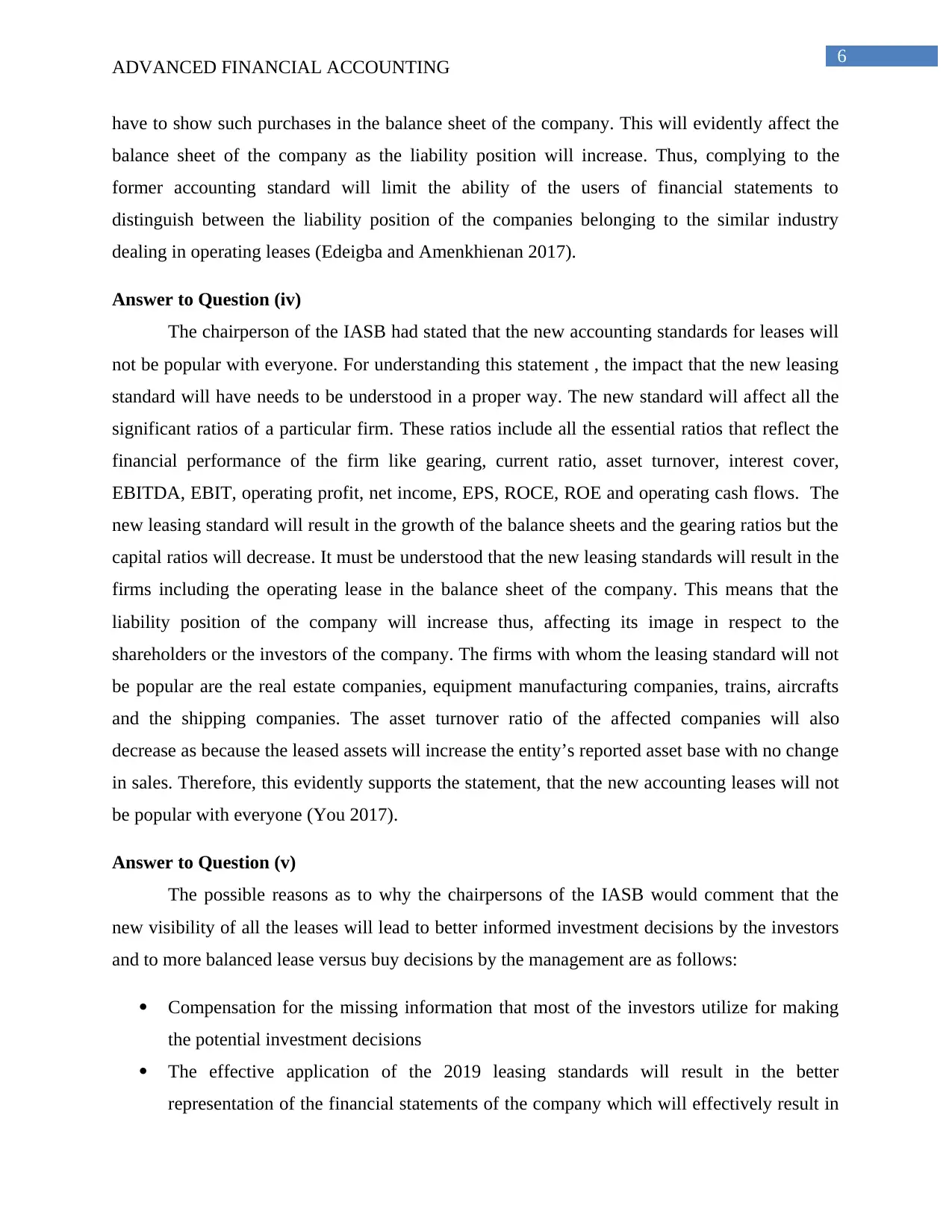
6
ADVANCED FINANCIAL ACCOUNTING
have to show such purchases in the balance sheet of the company. This will evidently affect the
balance sheet of the company as the liability position will increase. Thus, complying to the
former accounting standard will limit the ability of the users of financial statements to
distinguish between the liability position of the companies belonging to the similar industry
dealing in operating leases (Edeigba and Amenkhienan 2017).
Answer to Question (iv)
The chairperson of the IASB had stated that the new accounting standards for leases will
not be popular with everyone. For understanding this statement , the impact that the new leasing
standard will have needs to be understood in a proper way. The new standard will affect all the
significant ratios of a particular firm. These ratios include all the essential ratios that reflect the
financial performance of the firm like gearing, current ratio, asset turnover, interest cover,
EBITDA, EBIT, operating profit, net income, EPS, ROCE, ROE and operating cash flows. The
new leasing standard will result in the growth of the balance sheets and the gearing ratios but the
capital ratios will decrease. It must be understood that the new leasing standards will result in the
firms including the operating lease in the balance sheet of the company. This means that the
liability position of the company will increase thus, affecting its image in respect to the
shareholders or the investors of the company. The firms with whom the leasing standard will not
be popular are the real estate companies, equipment manufacturing companies, trains, aircrafts
and the shipping companies. The asset turnover ratio of the affected companies will also
decrease as because the leased assets will increase the entity’s reported asset base with no change
in sales. Therefore, this evidently supports the statement, that the new accounting leases will not
be popular with everyone (You 2017).
Answer to Question (v)
The possible reasons as to why the chairpersons of the IASB would comment that the
new visibility of all the leases will lead to better informed investment decisions by the investors
and to more balanced lease versus buy decisions by the management are as follows:
Compensation for the missing information that most of the investors utilize for making
the potential investment decisions
The effective application of the 2019 leasing standards will result in the better
representation of the financial statements of the company which will effectively result in
ADVANCED FINANCIAL ACCOUNTING
have to show such purchases in the balance sheet of the company. This will evidently affect the
balance sheet of the company as the liability position will increase. Thus, complying to the
former accounting standard will limit the ability of the users of financial statements to
distinguish between the liability position of the companies belonging to the similar industry
dealing in operating leases (Edeigba and Amenkhienan 2017).
Answer to Question (iv)
The chairperson of the IASB had stated that the new accounting standards for leases will
not be popular with everyone. For understanding this statement , the impact that the new leasing
standard will have needs to be understood in a proper way. The new standard will affect all the
significant ratios of a particular firm. These ratios include all the essential ratios that reflect the
financial performance of the firm like gearing, current ratio, asset turnover, interest cover,
EBITDA, EBIT, operating profit, net income, EPS, ROCE, ROE and operating cash flows. The
new leasing standard will result in the growth of the balance sheets and the gearing ratios but the
capital ratios will decrease. It must be understood that the new leasing standards will result in the
firms including the operating lease in the balance sheet of the company. This means that the
liability position of the company will increase thus, affecting its image in respect to the
shareholders or the investors of the company. The firms with whom the leasing standard will not
be popular are the real estate companies, equipment manufacturing companies, trains, aircrafts
and the shipping companies. The asset turnover ratio of the affected companies will also
decrease as because the leased assets will increase the entity’s reported asset base with no change
in sales. Therefore, this evidently supports the statement, that the new accounting leases will not
be popular with everyone (You 2017).
Answer to Question (v)
The possible reasons as to why the chairpersons of the IASB would comment that the
new visibility of all the leases will lead to better informed investment decisions by the investors
and to more balanced lease versus buy decisions by the management are as follows:
Compensation for the missing information that most of the investors utilize for making
the potential investment decisions
The effective application of the 2019 leasing standards will result in the better
representation of the financial statements of the company which will effectively result in
Paraphrase This Document
Need a fresh take? Get an instant paraphrase of this document with our AI Paraphraser
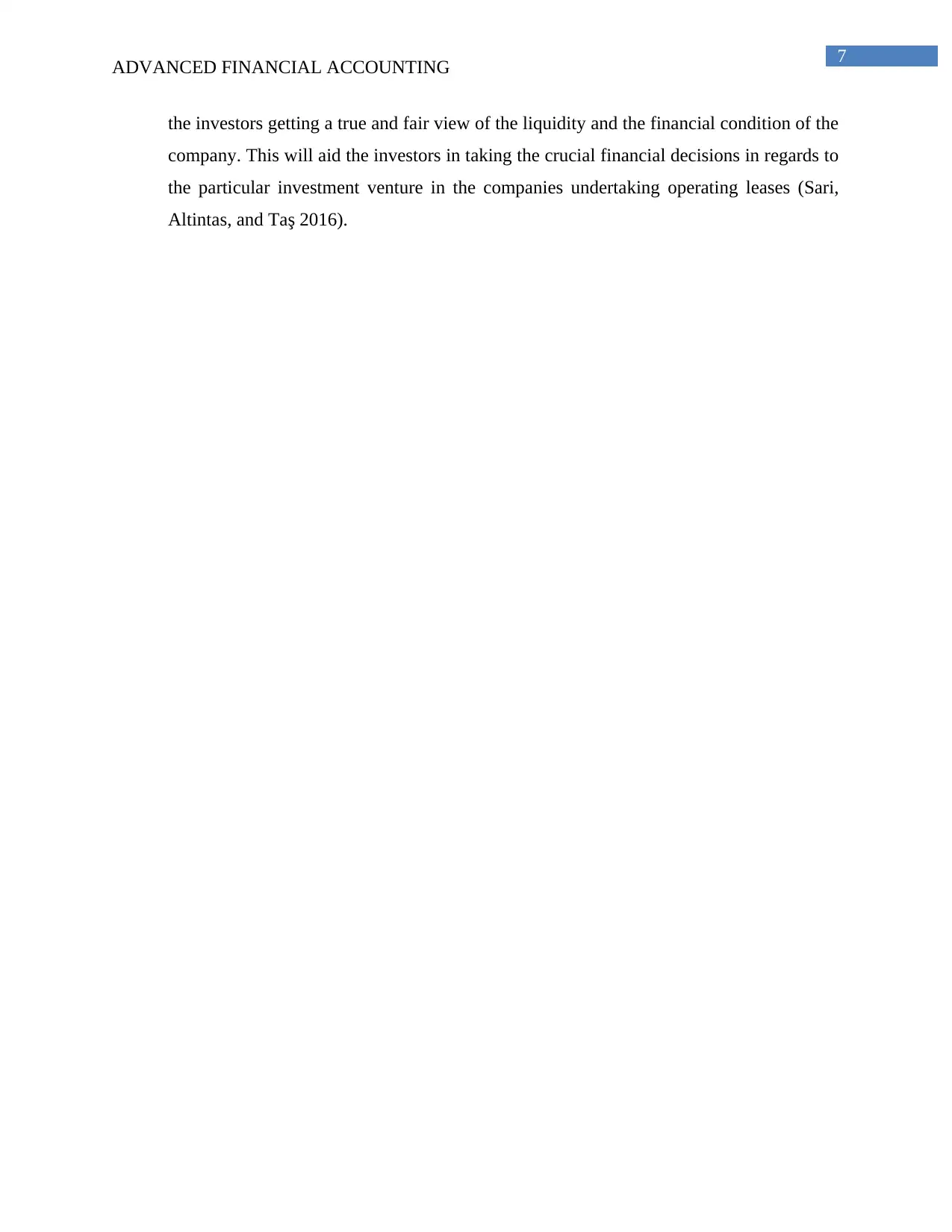
7
ADVANCED FINANCIAL ACCOUNTING
the investors getting a true and fair view of the liquidity and the financial condition of the
company. This will aid the investors in taking the crucial financial decisions in regards to
the particular investment venture in the companies undertaking operating leases (Sari,
Altintas, and Taş 2016).
ADVANCED FINANCIAL ACCOUNTING
the investors getting a true and fair view of the liquidity and the financial condition of the
company. This will aid the investors in taking the crucial financial decisions in regards to
the particular investment venture in the companies undertaking operating leases (Sari,
Altintas, and Taş 2016).
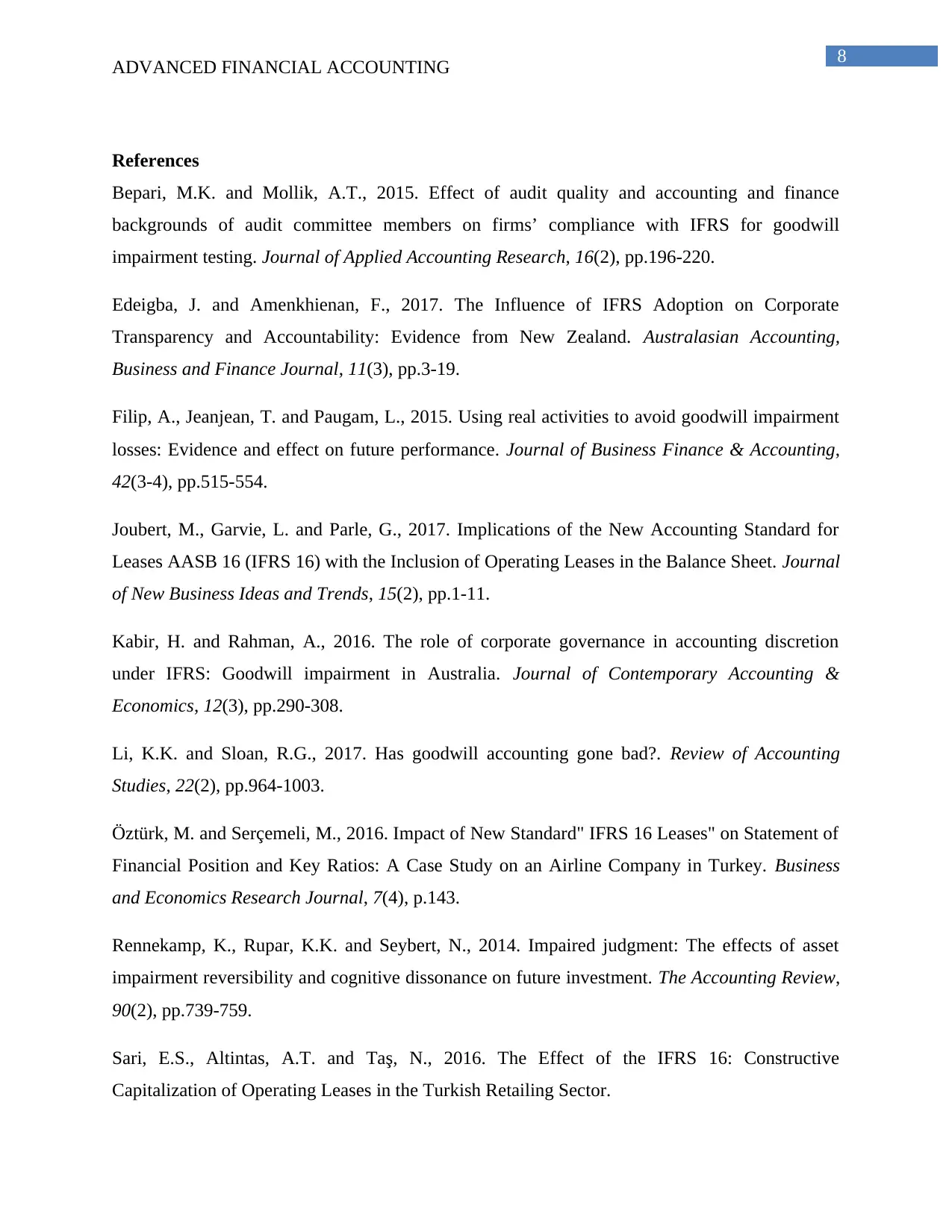
8
ADVANCED FINANCIAL ACCOUNTING
References
Bepari, M.K. and Mollik, A.T., 2015. Effect of audit quality and accounting and finance
backgrounds of audit committee members on firms’ compliance with IFRS for goodwill
impairment testing. Journal of Applied Accounting Research, 16(2), pp.196-220.
Edeigba, J. and Amenkhienan, F., 2017. The Influence of IFRS Adoption on Corporate
Transparency and Accountability: Evidence from New Zealand. Australasian Accounting,
Business and Finance Journal, 11(3), pp.3-19.
Filip, A., Jeanjean, T. and Paugam, L., 2015. Using real activities to avoid goodwill impairment
losses: Evidence and effect on future performance. Journal of Business Finance & Accounting,
42(3-4), pp.515-554.
Joubert, M., Garvie, L. and Parle, G., 2017. Implications of the New Accounting Standard for
Leases AASB 16 (IFRS 16) with the Inclusion of Operating Leases in the Balance Sheet. Journal
of New Business Ideas and Trends, 15(2), pp.1-11.
Kabir, H. and Rahman, A., 2016. The role of corporate governance in accounting discretion
under IFRS: Goodwill impairment in Australia. Journal of Contemporary Accounting &
Economics, 12(3), pp.290-308.
Li, K.K. and Sloan, R.G., 2017. Has goodwill accounting gone bad?. Review of Accounting
Studies, 22(2), pp.964-1003.
Öztürk, M. and Serçemeli, M., 2016. Impact of New Standard" IFRS 16 Leases" on Statement of
Financial Position and Key Ratios: A Case Study on an Airline Company in Turkey. Business
and Economics Research Journal, 7(4), p.143.
Rennekamp, K., Rupar, K.K. and Seybert, N., 2014. Impaired judgment: The effects of asset
impairment reversibility and cognitive dissonance on future investment. The Accounting Review,
90(2), pp.739-759.
Sari, E.S., Altintas, A.T. and Taş, N., 2016. The Effect of the IFRS 16: Constructive
Capitalization of Operating Leases in the Turkish Retailing Sector.
ADVANCED FINANCIAL ACCOUNTING
References
Bepari, M.K. and Mollik, A.T., 2015. Effect of audit quality and accounting and finance
backgrounds of audit committee members on firms’ compliance with IFRS for goodwill
impairment testing. Journal of Applied Accounting Research, 16(2), pp.196-220.
Edeigba, J. and Amenkhienan, F., 2017. The Influence of IFRS Adoption on Corporate
Transparency and Accountability: Evidence from New Zealand. Australasian Accounting,
Business and Finance Journal, 11(3), pp.3-19.
Filip, A., Jeanjean, T. and Paugam, L., 2015. Using real activities to avoid goodwill impairment
losses: Evidence and effect on future performance. Journal of Business Finance & Accounting,
42(3-4), pp.515-554.
Joubert, M., Garvie, L. and Parle, G., 2017. Implications of the New Accounting Standard for
Leases AASB 16 (IFRS 16) with the Inclusion of Operating Leases in the Balance Sheet. Journal
of New Business Ideas and Trends, 15(2), pp.1-11.
Kabir, H. and Rahman, A., 2016. The role of corporate governance in accounting discretion
under IFRS: Goodwill impairment in Australia. Journal of Contemporary Accounting &
Economics, 12(3), pp.290-308.
Li, K.K. and Sloan, R.G., 2017. Has goodwill accounting gone bad?. Review of Accounting
Studies, 22(2), pp.964-1003.
Öztürk, M. and Serçemeli, M., 2016. Impact of New Standard" IFRS 16 Leases" on Statement of
Financial Position and Key Ratios: A Case Study on an Airline Company in Turkey. Business
and Economics Research Journal, 7(4), p.143.
Rennekamp, K., Rupar, K.K. and Seybert, N., 2014. Impaired judgment: The effects of asset
impairment reversibility and cognitive dissonance on future investment. The Accounting Review,
90(2), pp.739-759.
Sari, E.S., Altintas, A.T. and Taş, N., 2016. The Effect of the IFRS 16: Constructive
Capitalization of Operating Leases in the Turkish Retailing Sector.
⊘ This is a preview!⊘
Do you want full access?
Subscribe today to unlock all pages.

Trusted by 1+ million students worldwide
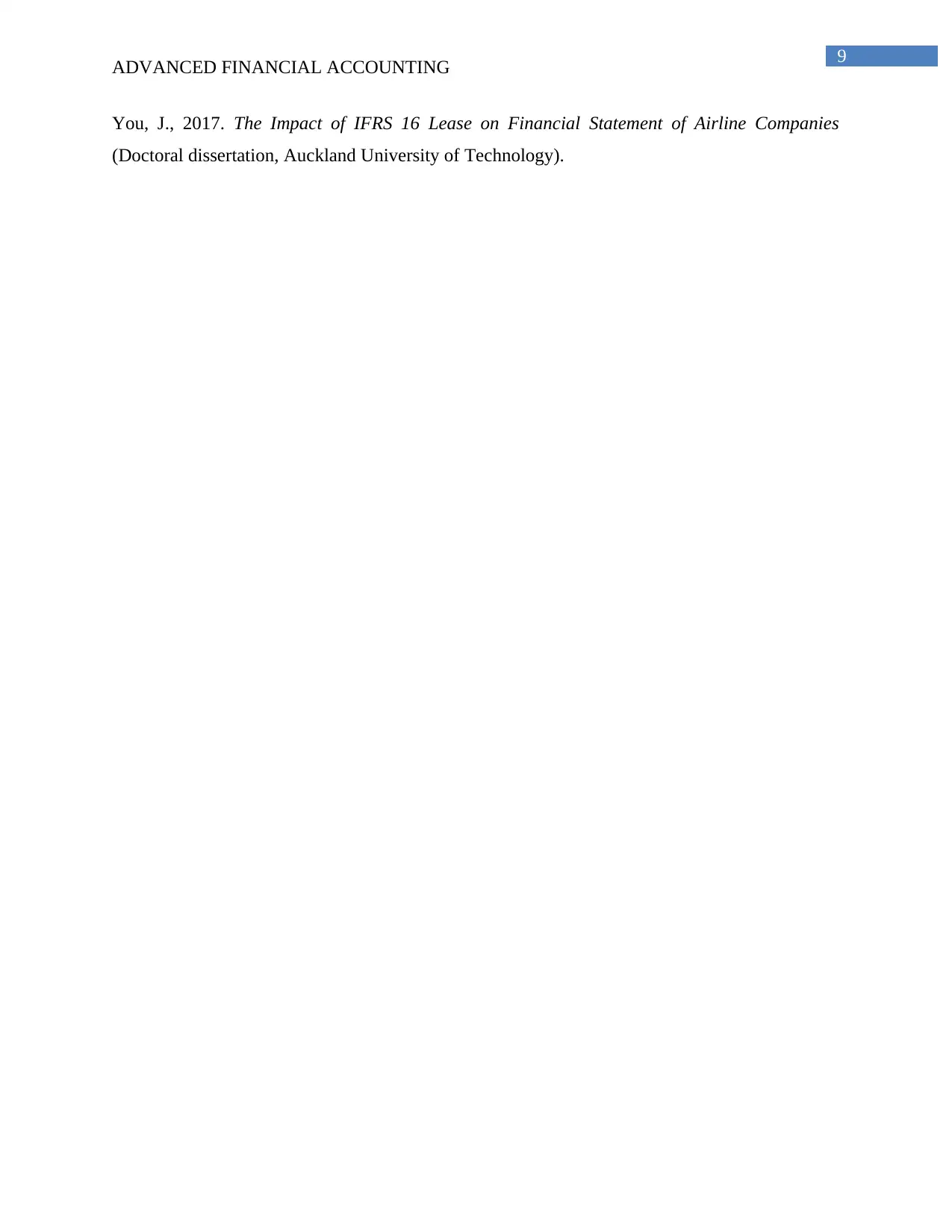
9
ADVANCED FINANCIAL ACCOUNTING
You, J., 2017. The Impact of IFRS 16 Lease on Financial Statement of Airline Companies
(Doctoral dissertation, Auckland University of Technology).
ADVANCED FINANCIAL ACCOUNTING
You, J., 2017. The Impact of IFRS 16 Lease on Financial Statement of Airline Companies
(Doctoral dissertation, Auckland University of Technology).
1 out of 10
Related Documents
Your All-in-One AI-Powered Toolkit for Academic Success.
+13062052269
info@desklib.com
Available 24*7 on WhatsApp / Email
![[object Object]](/_next/static/media/star-bottom.7253800d.svg)
Unlock your academic potential
Copyright © 2020–2025 A2Z Services. All Rights Reserved. Developed and managed by ZUCOL.





